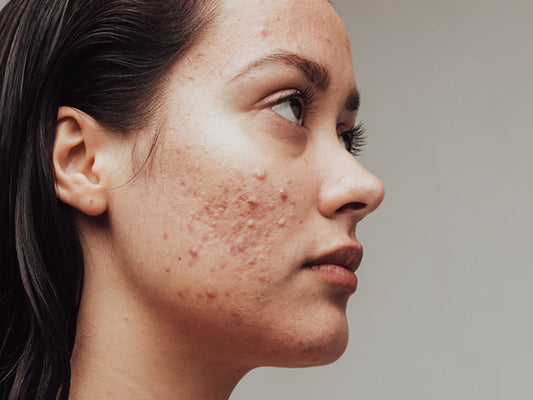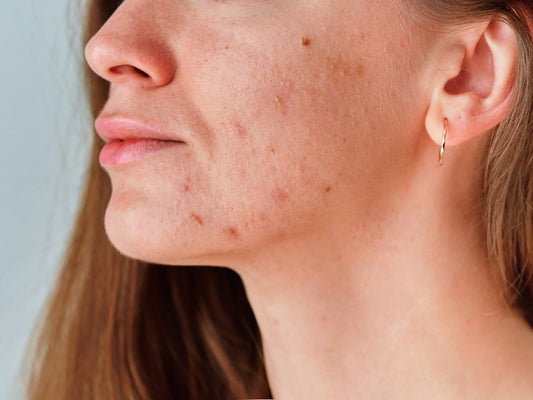Second puberty? Why adult acne happens & how to treat it
Published on 25 September 2025
Adult acne is a common skin concern, with many experiencing what’s often referred to as a ‘second puberty’. This resurgence of breakouts can be frustrating, especially for those who thought they had left teenage spots in the past.
Acne is most often associated with adolescence, but it’s not unusual for adults to suffer with breakouts. It is thought that approximately 15 - 20% of adults aged between 25 and 40 experience acne. There are several subsets of adult acne: ‘persistent acne’, which is the continuation of acne from adolescence; ‘late-onset acne’, which first occurs in adulthood;1 and ‘relapsing acne’, which refers to acne that heals and flares up continually throughout adolescence and adulthood.
Women are more likely to experience adult acne, related to the hormonal fluctuations that occur throughout a female’s life. Breakouts are mostly mild to moderate, consisting of open comedones (blackheads), closed comedones (whiteheads), papules (solid, inflamed bumps under the skin) and pustules (larger, pus-filled spots). Acne tends to be located on the lower section of the face, along the jaw, chin and neck.2
What is ‘second puberty’?
The term ‘second puberty’ is a colloquial way to describe the hormonal changes and physical symptoms that some people experience in adulthood. These changes can include a shift in mood, energy levels, weight fluctuations and skin-related changes, such as a change in skin type, increased congestion and breakouts.
While men also experience hormonal shifts throughout their lifetime, ‘second puberty’ is more likely to impact women, including non-binary individuals and transgender men. This is owed to the major biological factor of sex hormone fluctuation in females.3 Fluctuating hormones make us more vulnerable to episodes of anxiety and depression disorders, especially oestrogen withdrawal, which occurs during the perimenopause and menopause.
Furthermore, the adult acne that many women experience during hormonal fluctuations is closely associated with anxiety and depression,4 which highlights the importance of effective treatment.
Adult acne differs from teenage acne in both pattern and persistence. It is often more inflammatory, with spots appearing along the jawline, cheeks and neck. Unlike T-zone breakouts that are often experienced in adolescence, adult acne may not be associated with excessive oiliness. Instead, the skin may feel dry and sensitive.

Adult acne causes: Hormones, stress & lifestyle triggers
There are several triggers for adult acne, including genetics, UV radiation, lifestyle, diet, medications, skincare products and excessive skin washing. Other key aggravating factors for those experiencing a second puberty are hormones and stress:
Hormones
Hormones are one of the leading adult acne causes. Our sebaceous glands depend on the hormonal balance of androgens and oestrogens. Androgens, such as testosterone, dehydroepiandrosterone (DHEA) and dihydrotestosterone (DHT), increase sebum production, which leads to breakouts. For women, acne is likely to worsen before a period, due to fluctuating hormone levels. Big shifts in life such as pregnancy, the perimenopause and menopause are also likely to trigger changes in the skin. Furthermore, those who suffer with polycystic ovary syndrome (PCOS) are more likely to experience breakouts, owed to higher androgens.
Stress
Stress hormones like cortisol have been found to increase the production of adrenal androgens, resulting in heightened sebum production.5 Our sebaceous glands also react differently during periods of stress. The glands have been found to act as independent endocrine organs, producing and releasing hormones into the bloodstream. This function is regulated by corticotrophin-releasing hormone (CRH), which controls the body’s stress response. Since our CRH levels will change during periods of stress, there is an unequivocal relationship between stress levels and acne.6 Chronic stress can also disrupt our sleep, which makes it more difficult for the skin to protect and repair itself.
Quickfire adult acne Q&A
1. What’s the difference between teenage acne and adult acne?
Teenage acne occurs during puberty. It is caused by surging hormones stimulating more sebum, which mixes with dead skin cells and bacteria to clog pores. Teenage acne is usually located in the T-zone.
Adult acne can happen throughout adulthood. It is usually located on the lower part of the face, along the jawline, chin and neck. Spots are often inflamed and cystic. Adult breakouts usually last for longer and are more likely to result in hyperpigmentation and scarring, due to the slower pace of skin renewal as we age.
2. Does stress really cause adult acne?
Yes, stress is a notable trigger in many cases of adult acne. Stress hormones increase the production of adrenal androgens, leading to increased sebum production and oilier skin. This may then lead to breakouts. Chronic stress may also impact our sleep patterns, and when we don’t get enough rest, our skin also suffers.
3. What is the best skincare routine for adult acne?
The best skincare routine for adult acne should focus on products that soothe, balance and protect the skin. Start with a gentle cleanser to clean the skin and remove makeup and impurities. Follow with a targeted treatment exfoliates the skin and regulates the bacteria responsible for acne. Complete your routine with a hydrating moisturiser and a high-level, full-spectrum SPF in the morning.
Adult acne treatment: How it differs from teenage acne
Adult acne differs from teenage acne, and so treatment should differ, too. There are a number of factors that need to be considered, including the fact that mature skin is more prone to irritation, as well as being slower to respond to treatment.
Whilst the treatment of teenage acne typically focuses on targeting oil production and bacteria with strong ingredients, adult acne treatment requires a more gentle approach, incorporating products that balance the skin and protect the skin barrier. The goals are to create a healthy and resilient barrier, to regulate sebum, reduce inflammation and promote skin cell turnover.
The ultimate choice is BIRETIX, a holistic skincare solution from the dermatological experts, Cantabria Labs. Powered by innovative technologies and active ingredients, BIRETIX is formulated to tackle each stage of the spot cycle, exfoliating the skin and clearing pores, balancing oil production and regulating acne-causing bacteria, and soothing red, irritated skin.

The BIRETIX range includes a selection of gentle yet highly effective products, including a cleanser, moisturising fluid, hydrating cream, mask, micropeel and anti-blemish gels. It also features the incredible BIRETIX Double Correction Serum, a powerful treatment designed to target the needs of mature, acne-prone skin.
Discover the BIRETIX Regime for Adult Acne-Prone Skin, featuring the BIRETIX Double Correction Serum
The BIRETIX Double Correction Serum is regarded as one of the best serums for adult acne, late on-set or relapsing acne, slotting seamlessly into your skincare routine. It offers proven results after just two weeks of use, including regulating excess sebum, minimising pores and controlling the reappearance of blemishes. With regular use, it will reveal the skin’s natural radiance and promote a smooth, bright and youthful complexion.

Incorporate the Double Correction Serum into your daily skincare routine with a specialised BIRETIX regime. The BIRETIX Regime for Adult Acne-Prone Skin is a 3-step routine, consisting of our BIRETIX Cleanser, the Double Correction Serum, plus the top-selling Hydramat Fluid. This regime goes beyond typical acne treatments, tailored to meet the needs of adult skin that is experiencing hormonal changes and sensitivity. Not only will it shrink visible pores, reduce oil, improve hyperpigmentation and target early signs of ageing, but the innovative formulations also strengthen the skin barrier while respecting the skin’s natural balance.

The ultimate solution for fighting adult acne, the BIRETIX Regime for Adult Acne-Prone Skin is clinically proven to deliver results in just 14 days,7 powered by dermatological ingredients to target every aspect of acne-prone skin:
BIOPEP-15
BIOPEP-15 is a patented, plant-based technology designed to target 24 strains of acne-causing bacteria. It features the peptide Oligopeptide-10, which delivers broad-spectrum antimicrobial activity against Cutibacterium acnes, the primary bacteria linked to acne. Clinically proven to be effective with high tolerance and no side effects, BIOPEP-15 has a low risk of developing resistance, working effectively against acne strains that are already resistant to antibiotics.
RetinSphere® Technology
RetinSphere® Technology delivers retinoids through a dual system designed for both immediate and sustained release, helping to maximise effectiveness while minimising irritation. It combines two high-tolerance retinoids: hydroxypinacolone retinoate (HPR) and retinol encapsulated in glycospheres and microsponges.
The technology acts at multiple levels within the skin, supporting cell turnover, stimulating collagen and elastin production and increasing epidermal thickness. This contributes to improved skin texture, reduced fine lines and a brighter, more even skin tone.
Salicylic acid
Salicylic acid is a beta hydroxy acid (BHA) that promotes the natural shedding of dead skin cells, helps to unclog pores, reduces inflammation and redness and supports the healing of existing blemishes.
Glycolic acid
Glycolic acid is an alpha hydroxy acid (AHA) that provides excellent exfoliation. In doing so, it increases skin cell turnover, stimulates collagen production, reduces fine lines and brightens the complexion.
Niacinamide
Niacinamide, or vitamin B-3, is an anti-inflammatory ingredient that works to improve skin elasticity, enhance skin barrier function and lock in moisture. It also promotes a more clear and uniform skin tone.
Real user reviews
“I’m honestly astonished by what BIRETIX has done for my skin.”
Anne has spent years quietly managing her skin concerns while juggling the ups and downs of family life. Now in her peri-menopausal years, she’s experienced breakouts that left her feeling self-conscious.
“I absolutely love the Double Correction Serum! The scent is beautiful - light, fresh, and luxurious on my skin. It’s quickly become a new favourite. I’ve noticed my pores look more refined, and my complexion has a natural brightness to it. In fact, my boys often ask if I’m wearing makeup, and my youngest even said I look ‘glowy.’”
Top tips for treating adult acne
- Avoid washing your face too frequently
- Avoiding harsh exfoliants
- Do not scrub too hard
- Do not squeeze or pick at active spots
- Look for non-comedogenic products
- Avoid heavy, oil-based products
- Consider lifestyle adjustments, such as getting more sleep, eating a healthy balanced diet, and avoiding smoking and other pollutants
Advanced, dermatological product ranges like BIRETIX are incredibly effective for adult acne. However, you should always seek professional advice if your acne is ongoing or painful, if you're dealing with scarring or post-inflammatory hyperpigmentation (PIH), or if it's starting to affect your confidence or mental wellbeing.
For more severe cases of adult acne, we recommend contacting a professional skin clinic. Here, you will receive a targeted approach, catered specifically to your skin condition and symptoms. You’ll receive a detailed skin analysis, followed by a personalised treatment plan that is designed by someone who understands how acne behaves in adult skin. Rest assured, you can continue to use your BIRETIX products when seeking professional skin therapies, as the range is carefully designed to work alongside in-clinic, including laser and chemical peels.
Treating adult acne doesn’t always follow a standard formula. Everyone’s skin is different, which is why a holistic approach often sees better results, combining the standard treatments with adjunctive therapy.8 That’s why BIRETIX is available both directly to customers and through our network of professional skin clinics, giving you and your skin professional the flexibility to shape a routine that suits your needs.





